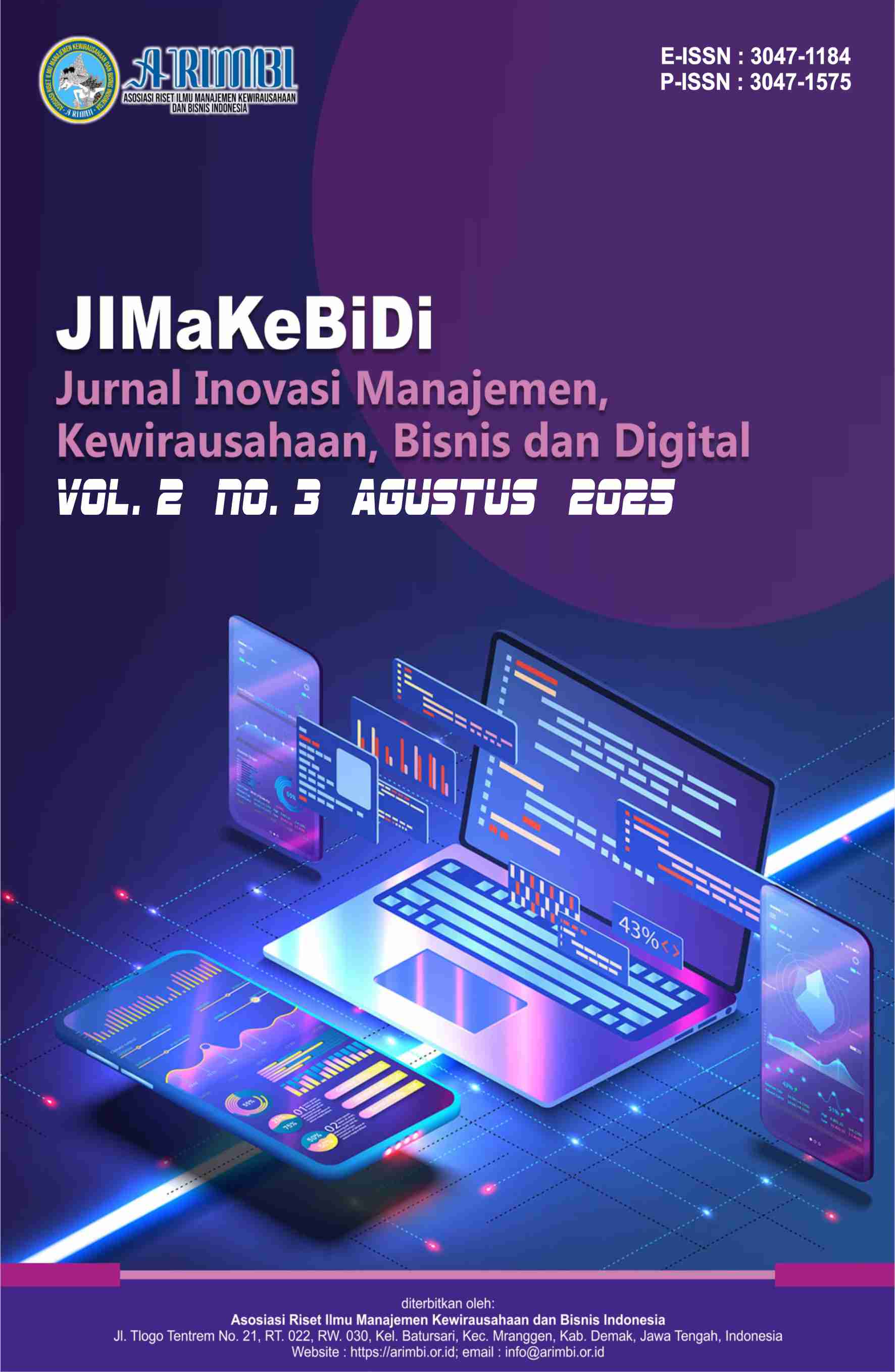The Influence of Experiental Marketing on Repurchase Intention and Customer Satisfaction of Restaurants in Surabaya
DOI:
https://doi.org/10.61132/jimakebidi.v2i3.780Keywords:
Customer Satisfaction, Experiential Marketing, Repurchase Intention, Restaurants, SurabayaAbstract
This research seeks to examine the impact of experiential marketing on customer satisfaction, its effect on repurchase intention, and the role of customer satisfaction in influencing repurchase intention among patrons of Resto All You Can Eat Surabaya. The study applies a survey approach, gathering data through questionnaires distributed to selected samples from the population. The analysis is conducted using the Partial Least Square method. The findings reveal that experiential marketing significantly influences customer satisfaction at Resto All You Can Eat Surabaya. This indicates that when elements of experiential marketing—such as sensory experiences, emotional responses, creative cognitive stimulation, physical engagement, lifestyle alignment, and social identity—are enhanced, customer demand also increases. Moreover, experiential marketing is shown to affect customers’ repurchase intention. In other words, the stronger the customers’ experience in terms of sensory, affective, cognitive, physical, lifestyle, and social identity aspects, the greater their willingness to make repeat purchases. Finally, customer satisfaction itself plays a crucial role in driving repurchase intention. When satisfaction is reflected in positive feelings, verbal appreciation, enjoyment, and fulfillment during the purchasing process, customers are more inclined to return and buy again at the restaurant. These results suggest that Resto All You Can Eat Surabaya—and similar businesses—should strategically invest in strengthening experiential marketing elements as a core part of their customer relationship and retention efforts. By creating memorable and meaningful dining experiences that engage customers on multiple levels, the restaurant can foster stronger emotional connections, increase satisfaction, and encourage long-term loyalty. Practical implementations may include improving ambiance, offering interactive dining elements, training staff to provide personalized service, and leveraging social media to enhance community and identity among patrons.
Downloads
References
Andreani, J. (2007). Experiential marketing (sebuah pendekatan pemasaran). Jurnal Manajemen Pemasaran, 2(1), 1-8.
Boyd, W., & Larreche. (2000). Manajemen pemasaran: Suatu pendekatan strategis dengan orientasi global (Edisi kedua). Jakarta: Erlangga.
Durianto, D., & Liana. (2004). Inovasi dengan iklan yang efektif: Strategi, program, dan teknik pengukuran. Jakarta: Elex Media Komputindo.
Engel, J. F., Blackwell, R. D., & Miniard, P. W. (2005). Perilaku membeli (Edisi ke-6, Jilid 1). Jakarta: Binarupa Aksara.
Handono, A., & Amelia, D. (2015). Analisis faktor-faktor yang mempengaruhi minat beli ulang pada produk McDonald di Surabaya. Jurnal Gema Aktualita, 4(1). http://dspace.uphsurabaya.ac.id/
Hawkins, D., & Mothersbaugh, D. (2007). Consumer behaviour: Building marketing strategy. New Jersey: McGraw-Hill.
Hellier, P. K., Geursen, G. M., Carr, R. A., & Rickard, J. A. (2003). Customer repurchase intention: A general structural equation model. European Journal of Marketing, 37(11/12), 1762-1800. https://doi.org/10.1108/03090560310495456
Junaidi, S. (2002). Pengaruh ketidakpuasan konsumen, karakteristik kategori produk, dan kebutuhan mencari variasi terhadap keputusan perpindahan merek. Jurnal Ekonomi dan Bisnis Indonesia, 17(1), 91-104.
Kertajaya, H. (2010). Connect: Surfing new wave marketing. Jakarta: PT Gramedia Pustaka Utama.
Kotler, P. (2006). Manajemen pemasaran (Edisi Milenium; B. Molan, Penerj.). Jakarta: PT Prenhallindo.
Kotler, P., & Keller, K. L. (2006). Marketing management (12th ed.). Upper Saddle River: Pearson Education, Inc.
Lin, C., Yeh, J. M., & Tseng, Z. M. (2009). Case study on knowledge management gaps. Journal of Knowledge Management, 9(3), 36-50. https://doi.org/10.1108/13673270510602755
Ndubisi, N. O., & Moi, C. L. (2005). Customers' behavioural responses to sales promotion: The role of fear of losing face. Asia Pacific Journal of Marketing and Logistics, 17(1), 32-49. https://doi.org/10.1108/13555850510672278
Olsen, S. O. (2002). Comparative evaluation and the relationship between quality, satisfaction, and repurchase loyalty. Journal of the Academy of Marketing Science, 30(3), 240-249. https://doi.org/10.1177/00970302030003005
Peter, J. P., & Olson, J. C. (2000). Consumer behavior: Perilaku konsumen (2nd ed.). Jakarta: Erlangga.
Prahalad, C. K., & Ramaswamy, V. (2004). The future of competition: Co-creating unique value with customers. New York: Harvard Business School Publishing. https://doi.org/10.1108/10878570410699249
Rohmat, D. J., & Sri, N. A. (2012). Analisis experiential marketing dan loyalitas pelanggan jasa wisata pada Taman Rekreasi Sengkaling Malang. Jurnal Manajemen dan Kewirausahaan, 14(2). https://doi.org/10.9744/jmk.14.2.128-137
Roscoe, J. T. (2007). Fundamental research statistics for the behavioral sciences (2nd ed.). New York: Holt, Rinehart & Winston.
Schmitt, B. (2001). Experiential marketing: How to get your customers to sense, feel, think, act, relate to your company and brand. New York: Free Press.
Schmitt, B. H., & Rogers, D. L. (2008). Handbook on brand and experience management. United Kingdom: Edward Elgar Publishing Limited. https://doi.org/10.4337/9781848446151
Simamora, B. (2002). Riset pemasaran: Falsafah, teori, dan aplikasi. Jakarta: PT Gramedia Pustaka Utama.
Smilansky, S. (2009). Experiential marketing: A practical guide to interactive brand experiences. India: Replika Press.
Swasta, B. D. H., & Irawan. (2001 & 2003). Manajemen pemasaran modern. Yogyakarta: Liberty.
Thamrin, A. (2003). Manajemen pemasaran. Jakarta: PT Rajawali Pers.
Tjiptono, F. (2005). Strategi pemasaran (Edisi kedua, Cetakan keenam). Yogyakarta: Penerbit Andi.
Downloads
Published
How to Cite
Issue
Section
License
Copyright (c) 2025 Jurnal Inovasi Manajemen, Kewirausahaan, Bisnis dan Digital

This work is licensed under a Creative Commons Attribution-ShareAlike 4.0 International License.





